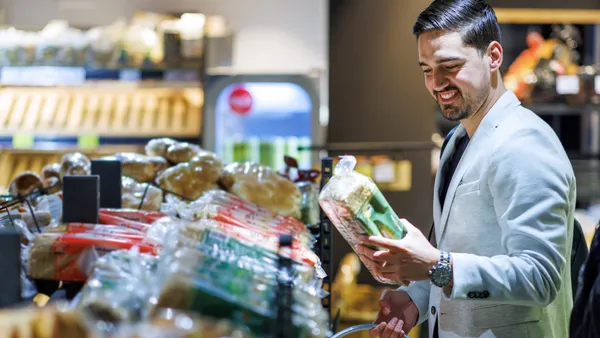Dive Brief:
- The retail foodservice market is expected to grow to $365 billion by 2030, up from today’s estimated value of $120 billion, according to a new report from the Food Marketing Institute (FMI) and consulting firm Kearney.
- With consumer demand for convenience on the rise, foodservice is playing a bigger role in retail, from grab-and-go meals to meal kits and made-to-order food counters. But the report says supermarkets aren’t doing enough to keep up with consumer demands.
- In order to remain competitive with grocery retailers and quick-service restaurants, FMI and Kearney recommend traditional grocers shift away from their current merchandising models and adopt foodservice operations that will differentiate them.
Dive Insight:
To compete against restaurants and win meal dollars, traditional grocers will need to make changes to its sourcing and offerings, according to the report.
The report includes several recommendations. For example, retailers could establish more local and national partnerships that will create a scalable supply chain and help them offer innovative products and experiences. Along with more foodservice offerings should come a store layout that complements foodservice, such as a comfortable seating area and an open kitchen, the study says.
Retailers also need to define their goals with foodservice, whether that’s driving revenue or fully competing with a restaurant nearby, and then choosing products that could resonate with their local community based on location and customer preferences.
In a modern retail foodservice model, Kearney recommends grocers stop using traditional metrics like cost, sales and gross margin and instead measure things like guest count, revenue per meal and share of eating occasion.
Retailers are widely working to improve their foodservice offerings. Among those who have executed it well are Whole Foods and Wegmans. Wegmans’ shoppers are fanatical about its prepared foods section, which includes pizza, Asian food, wings, salads, sandwiches and a burger bar. Their prepared meals are now also available for delivery.
Whole Foods' hot food bar also has a large fan base. Across the U.S., Whole Foods locations have everything from burrito bars and freshly made pizza to barbecue and local eateries that vary by market.
Traditional supermarkets like Albertsons and Kroger are also focusing on foodservice in their flagship stores (think made-to-order gyros at Albertsons’ Meridian flagship and tacos at Kroger’s On the Rhine food hall). While these are important testing grounds, their efforts don’t necessarily signify a move to foodservice at scale across all of their grocery stores.
While grocers need to determine how best to fit foodservice into its strategy, research shows shoppers want prepared food from their grocery stores. According to FMI's 2019 Power of Foodservice report, 63% of shoppers turn to semi-prepared and fully prepared foods from retail foodservice for dinner solutions, while 68% are interested in grab-and-go meals.













